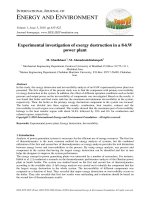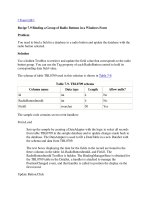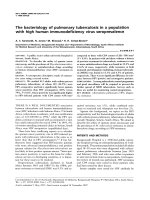Motion of an object in a viscous fluid
Bạn đang xem bản rút gọn của tài liệu. Xem và tải ngay bản đầy đủ của tài liệu tại đây (470.03 KB, 4 trang )
Motion of an Object in a Viscous Fluid
Motion of an Object in a
Viscous Fluid
Bởi:
OpenStaxCollege
A moving object in a viscous fluid is equivalent to a stationary object in a flowing fluid
stream. (For example, when you ride a bicycle at 10 m/s in still air, you feel the air in
your face exactly as if you were stationary in a 10-m/s wind.) Flow of the stationary fluid
around a moving object may be laminar, turbulent, or a combination of the two. Just as
with flow in tubes, it is possible to predict when a moving object creates turbulence. We
use another form of the Reynolds number 2 children in msubsup, defined for an object
moving in a fluid to be
2 children in msubsup =
ρvL
η (object
in fluid),
where L is a characteristic length of the object (a sphere’s diameter, for example),
ρ the fluid density, η its viscosity, and v the object’s speed in the fluid. If
2 children in msubsup is less than about 1, flow around the object can be laminar,
particularly if the object has a smooth shape. The transition to turbulent flow occurs
for 2 children in msubsup between 1 and about 10, depending on surface roughness and
so on. Depending on the surface, there can be a turbulent wake behind the object with
some laminar flow over its surface. For an 2 children in msubsup between 10 and 106
, the flow may be either laminar or turbulent and may oscillate between the two. For
2 children in msubsup greater than about 106, the flow is entirely turbulent, even at the
surface of the object. (See [link].) Laminar flow occurs mostly when the objects in the
fluid are small, such as raindrops, pollen, and blood cells in plasma.
Does a Ball Have a Turbulent Wake?
Calculate the Reynolds number 2 children in msubsup for a ball with a 7.40-cm
diameter thrown at 40.0 m/s.
Strategy
1/4
Motion of an Object in a Viscous Fluid
ρvL
We can use 2 children in msubsup = η to calculate 2 children in msubsup, since all
values in it are either given or can be found in tables of density and viscosity.
Solution
Substituting values into the equation for 2 children in msubsup yields
2 children in msubsup
(1.29 kg/m3)(40.0 m/s)(0.0740 m)
=
ρvL
η
=
2.11 × 105.
=
1.81 × 10 − 5 1.00 Pa ⋅ s
Discussion
This value is sufficiently high to imply a turbulent wake. Most large objects, such as
airplanes and sailboats, create significant turbulence as they move. As noted before, the
Bernoulli principle gives only qualitatively-correct results in such situations.
One of the consequences of viscosity is a resistance force called viscous drag FV that
is exerted on a moving object. This force typically depends on the object’s speed
(in contrast with simple friction). Experiments have shown that for laminar flow (
2 children in msubsup less than about one) viscous drag is proportional to speed,
whereas for 2 children in msubsup between about 10 and 106, viscous drag is
proportional to speed squared. (This relationship is a strong dependence and is pertinent
to bicycle racing, where even a small headwind causes significantly increased drag
on the racer. Cyclists take turns being the leader in the pack for this reason.) For
2 children in msubsup greater than 106, drag increases dramatically and behaves with
greater complexity. For laminar flow around a sphere, FV is proportional to fluid
viscosity η, the object’s characteristic size L, and its speed v. All of which makes
sense—the more viscous the fluid and the larger the object, the more drag we expect.
Recall Stoke’s law FS = 6πrηv. For the special case of a small sphere of radius R moving
slowly in a fluid of viscosity η, the drag force FS is given by
FS = 6πRηv.
(a) Motion of this sphere to the right is equivalent to fluid flow to the left. Here the flow is
laminar with 2 children in msubsup less than 1. There is a force, called viscous drag FV, to the
2/4
Motion of an Object in a Viscous Fluid
left on the ball due to the fluid’s viscosity. (b) At a higher speed, the flow becomes partially
turbulent, creating a wake starting where the flow lines separate from the surface. Pressure in
the wake is less than in front of the sphere, because fluid speed is less, creating a net force to the
left 2 children in msubsup that is significantly greater than for laminar flow. Here
2 children in msubsup is greater than 10. (c) At much higher speeds, where
2 children in msubsup is greater than 106, flow becomes turbulent everywhere on the surface and
behind the sphere. Drag increases dramatically.
An interesting consequence of the increase in FV with speed is that an object falling
through a fluid will not continue to accelerate indefinitely (as it would if we neglect air
resistance, for example). Instead, viscous drag increases, slowing acceleration, until a
critical speed, called the terminal speed, is reached and the acceleration of the object
becomes zero. Once this happens, the object continues to fall at constant speed (the
terminal speed). This is the case for particles of sand falling in the ocean, cells falling in
a centrifuge, and sky divers falling through the air. [link] shows some of the factors that
affect terminal speed. There is a viscous drag on the object that depends on the viscosity
of the fluid and the size of the object. But there is also a buoyant force that depends on
the density of the object relative to the fluid. Terminal speed will be greatest for lowviscosity fluids and objects with high densities and small sizes. Thus a skydiver falls
more slowly with outspread limbs than when they are in a pike position—head first with
hands at their side and legs together.
Take-Home Experiment: Don’t Lose Your Marbles
By measuring the terminal speed of a slowly moving sphere in a viscous fluid, one can
find the viscosity of that fluid (at that temperature). It can be difficult to find small
ball bearings around the house, but a small marble will do. Gather two or three fluids
(syrup, motor oil, honey, olive oil, etc.) and a thick, tall clear glass or vase. Drop the
marble into the center of the fluid and time its fall (after letting it drop a little to reach
its terminal speed). Compare your values for the terminal speed and see if they are
inversely proportional to the viscosities as listed in [link]. Does it make a difference if
the marble is dropped near the side of the glass?
Knowledge of terminal speed is useful for estimating sedimentation rates of small
particles. We know from watching mud settle out of dirty water that sedimentation
is usually a slow process. Centrifuges are used to speed sedimentation by creating
accelerated frames in which gravitational acceleration is replaced by centripetal
acceleration, which can be much greater, increasing the terminal speed.
3/4
F
Motion of an Object in a Viscous Fluid
There are three forces acting on an object falling through a viscous fluid: its weight w, the
viscous drag FV, and the buoyant force B.
Section Summary
• When an object moves in a fluid, there is a different form of the Reynolds
ρvL
number 2 children in msubsup = η (object in fluid), which indicates whether
flow is laminar or turbulent.
• For 2 children in msubsup less than about one, flow is laminar.
• For 2 children in msubsup greater than 106, flow is entirely turbulent.
Conceptual Questions
What direction will a helium balloon move inside a car that is slowing down—toward
the front or back? Explain your answer.
Will identical raindrops fall more rapidly in 5º C air or 25º C air, neglecting any
differences in air density? Explain your answer.
If you took two marbles of different sizes, what would you expect to observe about the
relative magnitudes of their terminal velocities?
4/4









